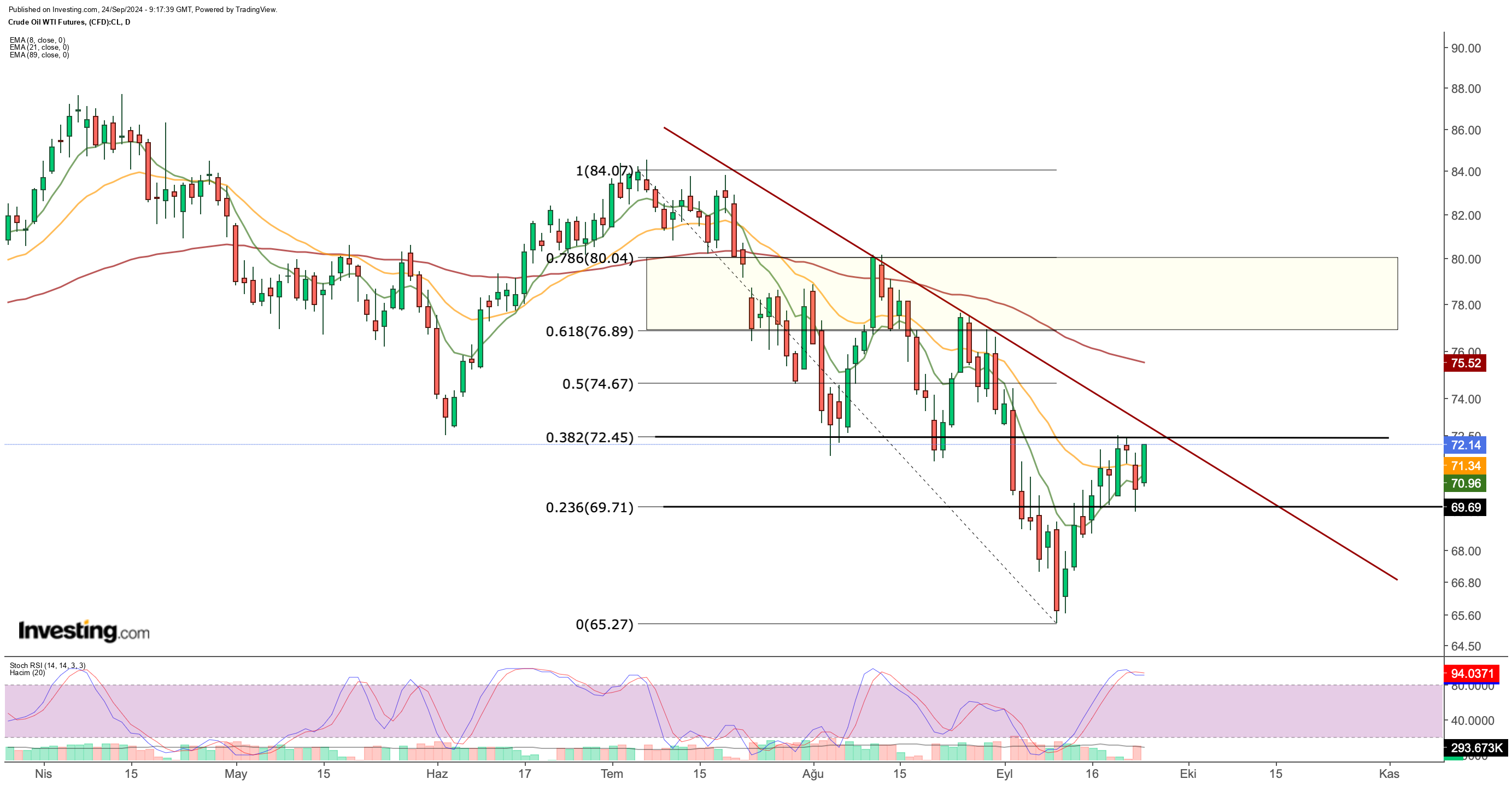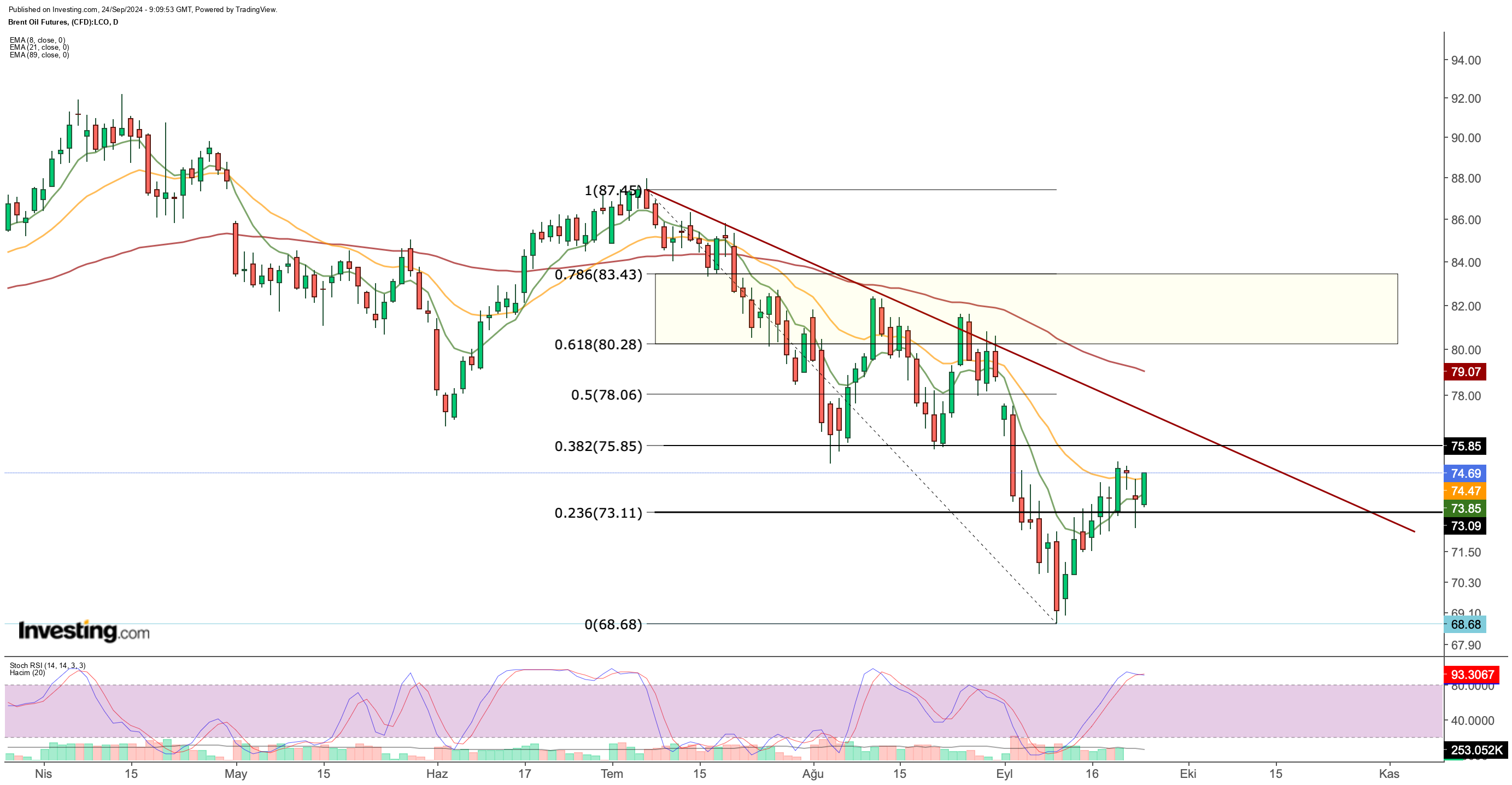- Crude oil prices are rebounding, fueled by heightened geopolitical tensions and new stimulus measures from China.
- Despite a recent pullback, both Brent and WTI futures are gaining momentum, with key technical levels suggesting potential upward movement.
- Traders should watch for how geopolitical risks and weather conditions along the U.S. Gulf Coast could further impact oil prices in the coming days.
- Looking for actionable trade ideas to navigate the current market volatility? Unlock access to InvestingPro’s AI-selected stock winners for under $9 a month!
Oil prices are on the rebound, driven by rising geopolitical risks and as major central banks across the globe begin to ease monetary policy.
Earlier this month, Brent futures fell to $68, their lowest level since November 2021, while WTI futures dropped to around $65, marking a yearly low.
Following a sharp pullback after September 9, oil futures have swiftly shifted into recovery mode, closing the past two weeks with positive momentum.
Although both Brent and WTI futures began this week with slight declines after last week’s rally, they quickly gained fresh upward momentum thanks to stimulus measures announced by China.
With this backdrop, let’s consider three tailwinds that can continue to fuel the rebound in crude oil prices.
1. Rising Geopolitical Concerns
The recent recovery can be attributed to escalating geopolitical tensions in the Middle East. As the risk of conflict spreading grows, concerns about oil supply are rising, potentially pushing prices higher in the coming days.
Furthermore, global monetary expansion could contribute to this upward trend. In the U.S., the world's largest crude oil producer, growing fears of a recession put crude oil prices under pressure.
However, efforts by developed countries to support their economies through interest rate cuts may bolster oil prices.
2. China’s Stimulus
Today's announcement of stimulus measures from China exemplifies this trend of monetary easing. As the world’s largest oil importer, China’s actions have become a significant catalyst for oil prices amid rising tensions in the Middle East.
The People's Bank of China surprised markets by lowering its benchmark lending rates, aiming to counter an economic slowdown. This move marks the largest stimulus effort since the pandemic and signals a decisive step toward ending a deflationary period.
Additionally, China has raised its petroleum product export quotas, increasing the average export quota from 850,000 barrels per day (bpd) from January to August to 950,000 bpd in the fourth quarter.
This adjustment not only supports oil prices but also helps mitigate downside risks. However, uncertainty persists regarding the sustainability of this upward trend, as factors like continued low demand and the ineffectiveness of monetary policies could weigh on prices.
3. Unfavorable Weather Conditions
In the short term, weather conditions along the U.S. Gulf Coast may also impact oil prices. A hurricane is expected by the weekend, posing a potential risk to offshore oil production.
With U.S. {{0|crude oil inventories} } at their lowest levels of the year, this factor could further support rising prices.
Technical Outlook for Brent and WTI Futures
From a technical standpoint, Brent crude is striving to recover from its recent lows. The recent decline wave that began in July led to a double-top formation during August's recovery, indicating that the average 8% downward cycle has ended with a break above the $75 level.

As we approach mid-September, the new recovery phase has turned the previous resistance at $73 (Fibonacci 0.236) into a support level.
The short-term target is set at $75.85 (Fibonacci 0.382). If this resistance breaks, along with a positive shift in the exponential moving average (EMA) values, we could see Brent futures advance toward the $80-83 range.
On pullbacks, $73 could act as a critical support level; falling below this threshold could invalidate the recent recovery and resume the downward trend below $70.
Nonetheless, the current outlook suggests a greater likelihood of continued upward movement, with a potential pullback toward $73 strengthening the recovery phase.
Key Levels for WTI Futures
WTI futures also present a similar scenario, rising to $72 today as they inch closer to breaking their short-term downtrend. After finding support around $65 this month, WTI has entered recovery mode and stepped into the $70 range.
The next key level to monitor is a seamless move above the $72 mark. If this rise holds with daily closes, WTI could follow Brent’s lead toward the $76-80 range.

On the downside, maintaining support around $69.7 is crucial for sustaining the upward trend.
Looking ahead, as governments implement expansive pandemic-era policies with their stimulus measures, we may witness a resurgence akin to the momentum seen in 2021-2022.
The driving force behind this revival will be demand, making the effectiveness of upcoming economic stimulus measures vital in determining oil price trajectories.
***
Disclaimer: This article is written for informational purposes only; it does not constitute a solicitation, offer, advice, counsel or recommendation to invest as such it is not intended to incentivize the purchase of assets in any way. I would like to remind you that any type of asset, is evaluated from multiple perspectives and is highly risky and therefore, any investment decision and the associated risk remains with the investor.
